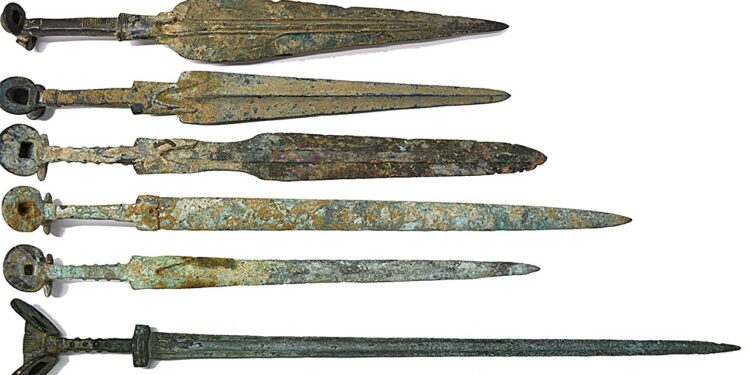Credit: Journal of Archaeological Sciences (2024). DOI: 10.1016/j.jas.2024.106018
For the first time, an imaging method has been used to study Iranian Iron Age bronze swords, revealing significant modern modifications that prove the weapons were modified to increase their commercial value on the illicit market antiques.
Iranian bladed weapons from the Early Iron Age are crucial to understanding metalworking technologies in one of the world’s heartlands of metallurgical innovation, the ancient Near East. Illicit alteration and falsification of ancient objects complicate efforts to trace the evolution of metalworking techniques to the dawn of the Iron Age, 3,000 years ago.
Reliable identification of these alterations is essential not only for reconstructing ancient technological innovation, but it also helps uncover – and ultimately combat – the hidden practices of the illicit antiquities trade.
Early application of Iranian Iron Age bronze weapons
Led by a team from Cranfield University, ISIS Neutron and Muon Source and the British Museum, the research used neutron tomography to see the internal structure of objects and detect the use of glue and other tools and modern materials.
The article, “Neutron tomography reveals significant modern modifications in Iranian Iron Age swords,” is published in the Journal of Archaeological Sciences.
Neutron tomography, which uses neutrons rather than photons to create images, is not yet a common practice in archaeological science, but it has significant advantages over better-known X-ray imaging techniques. It is particularly effective for highlighting organic matter, glues used to modify objects and the structure of the object’s materials.
Construction of pastiches
The research focused on a collection of swords recently seized by British Border Force and currently held at the British Museum, awaiting repatriation to Iran.
The research, approved by Iranian authorities, revealed that the swords had been modified recently, with bronze blades replacing the original iron blades, creating what are known as “pastiches”. These types of objects are assembled from authentic, but fragmentary, ancient artifacts, creating a sort of “Frankenstein’s monster” in an attempt to increase their value. In this case, the creation of pastiches masks the authentic bimetallic nature of the artifacts and the true nature of their construction.
Modern falsification detected
The analysis, carried out at the ISIS Muon and Neutron Source, operated by the Oxfordshire Science and Technology Facilities Board, revealed detailed elements of construction and modification, including the use of glue, that the Counterfeiters attempted to hide it from unsuspecting buyers.
These included modern boreholes, identified as such by their regular outline and circular section. Oddly, one sword even contained a fragment of a modern drill bit still embedded in the weapon.
Implications of property crime
The research findings show the prevalence and problem of modern forgery in antiquities trafficking, with implications for heritage crime and the authenticity of museum collections around the world.
Alex Rodzinka, a Ph.D. student in archeology at Cranfield University and lead author of the paper, commented: “Bimetallic objects are important in helping us understand the transition from the use of bronze to the use of iron. Illicit modifications make this task much more complicated. »
“Neutron analyzes were crucial in determining the true extent of modern modifications on ancient Iranian swords,” said Anna Fedrigo, an imaging scientist at ISIS’s muon and neutron source. “Any bronze-bladed sword with iron in the hilt may turn out to be a pastiche.”
Nathaniel Erb-Satullo, senior lecturer in archaeological sciences at Cranfield University, said: “Iran has been a center of metallurgical innovation for thousands of years, although many aspects of these traditions are poorly understood. . an important step towards greater recognition of these early traditions of complex metallurgy. »
The swords, part of a larger tampered collection, will be displayed at the British Museum before being repatriated to Iran.
More information:
Alex E. Rodzinka et al, Neutron tomography reveals significant modern modifications in Iranian Iron Age swords, Journal of Archaeological Sciences (2024). DOI: 10.1016/j.jas.2024.106018
Provided by Cranfield University
Quote: Using advanced scanning technique, confiscated Iranian Iron Age swords revealed to be pastiches (October 8, 2024) Recovered on October 8, 2024 from
This document is subject to copyright. Except for fair use for private study or research purposes, no part may be reproduced without written permission. The content is provided for informational purposes only.



